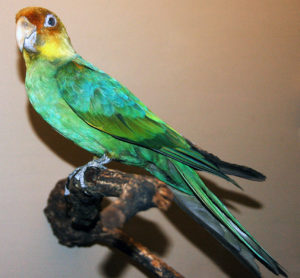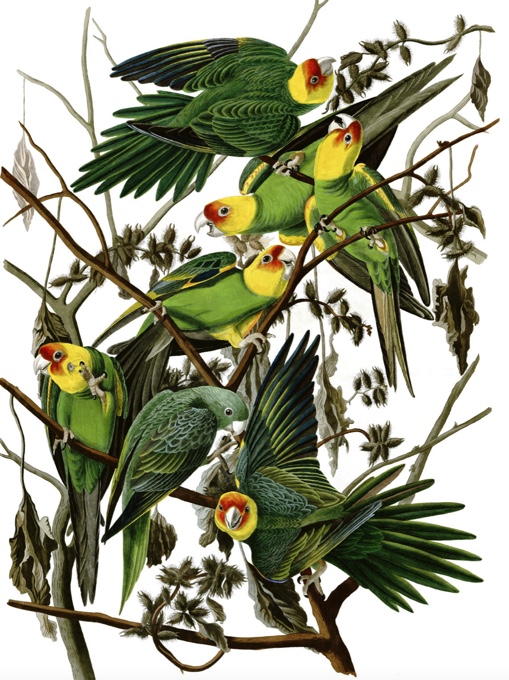The last known Carolina Parakeet (Cornuropsis carolinensis) died in captivity at the Cincinnati Zoo on February 21, 1918.

Carolina Parakeets were common birds in the eastern United States at the time of European settlement. Sir Walter Raleigh mentioned their presence in the Carolinas in a 1596 book, comparing them to the parrots he had encountered in Central America. It was, in fact, a species of parrot, the only species in its genus.
They were much larger than our modern image of domesticated “parakeets,” more similar in size and shape to the Mourning Dove—about a foot long with a wingspan just under two feet. And they were brightly colored—a green body grading into a yellow neck and head, ending in a reddish orange crown and bill. The birds were noisy and highly social, gathering together in large flocks, sometimes so large that early observers said they blocked out the sun. They did not migrate, apparently, but spent a great deal of time in the air—they preferred to fly rather than climb, walk or hop, even just to turn around on a branch. No one seems to know where they nested, but amateur ornithologists of the time thought they used cavities such as hollow trees. Consequently, they were most common in forests, along wooded edges and forested river bottoms.

From great abundance, they fell rapidly to low levels and eventually extinction by about 1900. The causes of extinction are many, and somewhat mysterious. The birds were hunted for food and for their beautiful feathers, highly desired for decorations on Victorian ladies dresses and hats. The birds aggregated in large flocks, which responded to alarm calls of individuals not by fleeing, but by flying to the location of the distressed birds. Consequently, when hunters shot one bird, many others came to the sound—making massive killing easy. Ecologists also surmise that the spread of honeybees, introduced into the eastern U.S. in colonial times, caused competition for nesting sites, and the birds lost out to the bees. In the end, however, the last wild individuals probably succumbed to diseases caught from domestic poultry.
The last wild individual Carolina Parakeet was reportedly killed in Okeechobee County, Florida, in 1904. The last known specimen, a male named Incas, died in captivity at the Cincinnati Zoo, on February 21, 1918. Curiously, the last specimen died in the same aviary where the last known Passenger Pigeon, Martha, had died four years earlier (read more here).
References:
Colvin, Thagard. No date. The Extinct Carolina Parakeet. Outdoor Alabama. Available at: http://www.outdooralabama.com/extinct-carolina-parakeet. Accessed February 20, 2017.
John James Audubon Center at Mill Grove. The last Carolina Parakeet. Available at: http://johnjames.audubon.org/last-carolina-parakeet. Accessed February 20, 2017.
Powell, William S. 2006. Carolina Parakeet. Encyclopedia of North Carolina. Available at: http://www.ncpedia.org/carolina-parakeet. Accessed February 20, 2017.
